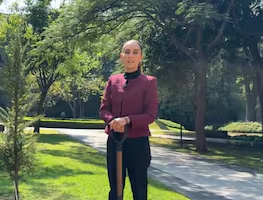Más Información

Sheinbaum cierra el 2024 con mensaje de Año Nuevo; recuerda legado de AMLO y reafirma continuidad de la 4T

Científicos de la UNAM desarrollan lombricompostaje; una alternativa eficiente para el manejo de heces caninas
From any tablet, mobile, or laptop you'll be able to access the largest virtual retrospective on Frida Kahlo ever. The Mexican painter is the first of the 20th-century artists from which Google Arts & Culture brings this online tour with the largest number of works, accessible to anyone, anywhere, together with the support of 33 Mexican and other foreign institutions.
There are 800 items in total: 69 paintings – five with the possibility to zoom in on small details – 700 files, including letters, photos, and portraits; and virtual walkthroughs of the Blue House, where the artists was born and died, and the Studio House of Diego River and Frida Kahlo.
Photographs, videos, audios, and insight texts written by curators and researchers – such as Juan Coronel Rivera and Alejandro Rosas, among others – are part of this experience which covers the legacy and character of Frida Kahlo. The material is available in four languages: English, Spanish, French, and Portuguese.
You can check the project at https://artsandculture.google.com/project/frida-kahlo or download the Google Arts & Culture App.
The operations manager of the Institute, Luisella Mazza defined it as an ambitious undertaking: “It's the first digital retrospective on the work and legacy of Frida Kahlo. The technology used arrives for the first time to Mexico and it's called Art Camera. Google is offering another way to display images and cultural heritage.
This virtual walkthrough, described as an “in-depth analysis of Frida's life, art, love, and legacy through the eyes of experts and those inspired by her talent,” has five sections and each visitor can choose how to live this experience.
Regarding copyright, Mazza says these come from the project partners: public and private museums, galleries, and national and international art institutions and collectors.
“Cultural institutions decide what works and what stories they share online. Google offers free technology, images and stories come from cultural institutions. Google has no rights in this regard, it is a technology and digitization platform for these partners. Sharing their cultural heritage allows them to stop whenever they want; every image has information on the rights and there is no doubt who the images belong to,” said Mazza, adding that it was a “free investment” and that they wouldn't monetize cultural investment.
am








